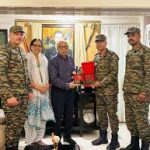Perched at a dominating height of about 2200 meters (7200 feet) above the sea level in the remote corner of India, is a small museum overlooked by snowcapped peaks, the essence of a community’s metamorphosis locked behind glass displays. Welcome to the one of its kind ‘Tribal art museum’ dedicated to (once the guardians of the Indo-Tibet frontier and trade routes) the Bhutias ; an offbeat single handed effort by local historian ‘Shersingh Pangtey’ who went all out in the year 2000 to plant the flag of Bhutia culture ,art and sustenance at Munsyari of district Pithoragarh. The word Bhutia refers to a group of people who migrated from the highlands of Tibet around the 9th century CE, settling in the mountain ranges along the Indo-Tibet border.
Many of them have retained aspects of Tibetan culture while adopting elements of Hindu culture too. Today it is estimated that there are more than a million Bhutias, about 2 lakh of whom are in India itself. Spread all along the Himalayan belt from Ladakh till Arunachal Pradesh the community has adopted different names in these states and have a good footprint in the neighbouring Nepal, Bhutan too. In the state of Utrakhand the Bhutias can be divided into 7 groups who inhabit 7 river valleys ,3 in the Garhwal region( Jadh, Mana and Niti) and 4 in the eastern Kumaon (Johar, Darma, Byans, and Chaudans) . Their main traditional occupation used to be Indo-Tibetan trade with limited exposure to agriculture and pastoralism.
Once the guardians of the Indo-Tibetan trade route as also the frontrunners for recruitment by the British as reconnaissance personnel during the ‘Great Game’ days of the mid and later half of the 19th century, the Bhutias used to be one of the most prosperous high altitude communities of this country. My 3 years stint in the services while posted at Pithoragarh lent me ample time to dwell into the culture and living of this tribe in detail. This was again renewed recently when I went to Pithoragarh in 2019. Each new interaction with them gave me new insights into their intrepid way of existence.
Way back in 1991 when this masterpiece of tribal museum at Munsyari was not even heard of, the only means of collecting any information of these people was a one –on—one meeting with them in their mountainous villages; a tough call indeed. But as stated above local historian ‘Shersingh Pangtey’ has made things easier by putting all information covering this tribal community under one roof at Munsayri without much intervention from the local authorities. A commendable effort indeed at that height all by himself.
Over the last 60 years or so their way of life has changed dramatically influenced by the Geo-political developments casting a shadow all along the Sino-Indian border. With the traditional trade routes a strict ‘No go’ for the community, their livelihoods got even tougher forcing them to migrate to lower reaches of the state of Uttarakhand . In a way the community has added to the growing syndrome of ‘Ghost villages” all along the border belt of Uttarakhand along with the other locals guided by the primal instinct of survival. Though literally, this tribe is spread from the outskirts of Pithoragarh district town right till Munsyari /Johar valley near Milam glacier, it will take an avid traveller the last of ounces of his energy to go deeper into such areas.
Inside the tribal heritage museum of Bhutiasone can find rows of black and white photographs interspersed with coloured ones from the 1950s to 1980s offering snapshots into a way of life long forgotten. In fact if one goes to the innermost valleys of Darma, Byans and Munsyari he/she will find hardly any Bhutias over there. The tribal museum depicts many ways of Bhutia tribal life items like ‘Anwal coat’, which is a type of thick ,double woven shepherd coat for protection from rain and cold.
Before 1962, the Bhutia community in particular Kumaon region used to weave Yak wool and pashmina, trading other goods for goats from Tibet. But like the ‘Anwal coat ,thick ‘Komaul and Odre(traditional long dress made from wool) have fallen out of fashion and have been replaced by cotton sweatshirts. It seems the Bhutias too have been caught in the whirlpool of convenience and modernity. Now most clothes in the region are made of ‘angora wool ‘and sold to the tourists.
The tribal art museum depicts photos/models of a man crouching by a ‘Gharat’(water mill), the traditional water mills once common across the mountains of the Himalayas for grinding grains. Rising temperatures and reduced water flow in many rivers and streams has made these Gharats a thing of the past.Occasionally, abandoned water mills can be spotted by what little is left of once powerful water courses. In addition the museum has very carefully kept traditional snow shoes, some of which are more than 250 years old, alongside are traditional paintings of village life in area of Munsyari.
A similar tribal museum on the lines of above discussed Munsyari museum is at Dharchula ,often called as ‘Pride of Dharchula’ going by the name of ‘Rung museum’ .I had the privilege of visiting this ‘Rung museum’ in 2019 ,when I had come to Pithoragarh on way to Badrinath temple. Opened in the year 2017, this tribal museum at Dharchula opened its doors to the locals and tourists who were eager to get a glimpse of the life and times of elusive ‘Rung tribes/Bhutiyas of Pithoragarh. While visiting Pithoragarh in May 2019 I happen to go to this unique museum with family which is housed in a double storied pink building hard to miss. It stands tall in the heart of Dharchula main market, on the Indian Nepal road.
Open six days a week from 10 am to 1 pm and then 4 pm to 6 pm except on Sundays and government holidays, I was lucky to scrape through the said timings and visit the said museum and soak in its entirety. A wonderland of ancient artefacts ,buildings, art and manuscripts some over 100 to 250 years old bring alive tales of these distant tribes which live in the Darma ,Chaudas and Vyas valleys even today. Called the ‘pride of Dharchula’ this Rung museum is continuously adding more and more exquisite items to its catalogue that gives the walk- ins a glance of the rich cultural heritage of the tribes that flourish in this part of the hill state.
Handlooms, artistic wooden door and window frames, cloth, jewelry, utensils, crop, costumes bring alive a typical Bhutia /Rung village within the museum’s four walls. Local historians like Shersingh Pangtey are doing a yeoman’s job by bringing alive such tribes back on the radar of Indian psyche which long have faded from their thinking horizon. In fact India has unfortunately not been able to cash on the strategic location and importance of these Bhutia /Rung tribes by going all out and rehabilitating them in their natural habitat ; achieving twin objectives in the bargain. Firstly that of populating our frontier areas and secondly acting as eyes and ears of the government to eavesdrop on our northern adversary (china). With China actively pursuing its twin policy of amalgamating its national security with that of local security of the border inhabitants, it is high time that India too picks up cues from its northern neighbour and makes the above as its state policy to ace him in his own game. Bhutiyas will be all too willing to do their bidding to further India’s strategic aims on its northern frontiers. In totality it is worth going to such far off places to explore actual India which lie hidden in its various recesses.
(The writer is a retired army officer and can be approached on his email…[email protected])








